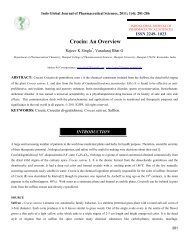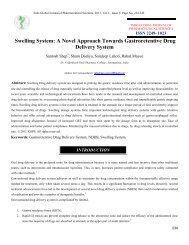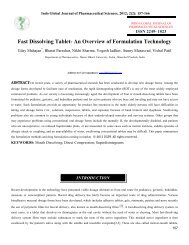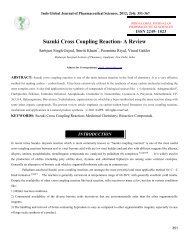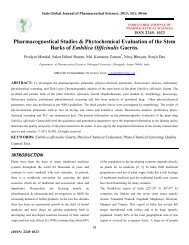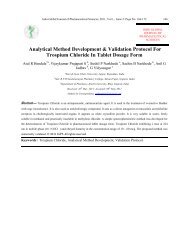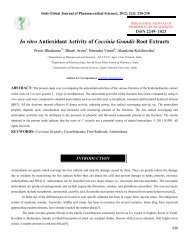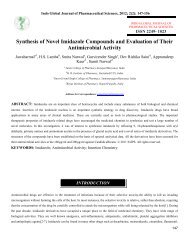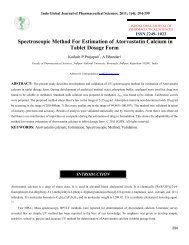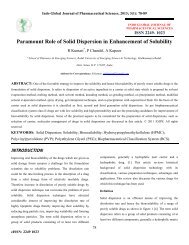Formulation & Evaluation of Curcuminoid Based Herbal Face Cream
Formulation & Evaluation of Curcuminoid Based Herbal Face Cream
Formulation & Evaluation of Curcuminoid Based Herbal Face Cream
You also want an ePaper? Increase the reach of your titles
YUMPU automatically turns print PDFs into web optimized ePapers that Google loves.
Indo-Global Journal <strong>of</strong> Pharmaceutical Sciences, 2011, Vol 1., Issue 1: Page No. 77-84 77<br />
<strong>Formulation</strong> & <strong>Evaluation</strong> <strong>of</strong> <strong>Curcuminoid</strong> <strong>Based</strong> <strong>Herbal</strong> <strong>Face</strong><br />
<strong>Cream</strong><br />
Sahu Alakh N *a , Jha S b and Dubey S D c<br />
a Department <strong>of</strong> Pharmaceutics, I.T, Banaras Hindu University, Varanasi-221005, India<br />
b Department <strong>of</strong> Pharmaceutical Sciences, Birla Institute <strong>of</strong> Technology. MESRA, Ranchi, India<br />
c Department <strong>of</strong> Dravyaguna, Faculty <strong>of</strong> Ayurveda, IMS, Banaras Hindu University, Varanasi-221005, India<br />
Received: 08 th Dec. 2010; Accepted: 09 th Jan 2011<br />
Address for Correspondance: ansahu.phe@itbhu.ac.in<br />
INDO GLOBAL<br />
JOURNAL OF<br />
PHARMACEUTICAL<br />
SCIENCES<br />
Abstract— <strong>Formulation</strong> <strong>of</strong> herbal cosmeceutical in the form <strong>of</strong> a face cream has been done. <strong>Curcuminoid</strong>s from Curcuma<br />
domestica Val. (turmeric) has been incorporated in the formulation. Pharmacognostical standardization <strong>of</strong> turmeric has been<br />
done as per Indian <strong>Herbal</strong> Pharmacopoeia [IHP]-2002 to ensure the genuinity <strong>of</strong> the crude turmeric rhizomes. It includes<br />
taxonomical authentication, morphological characterization, powdered drug microscopy, identification tests <strong>of</strong> turmeric<br />
powder and quantitative standards - that are foreign organic matter(0.43%), alcoholic soluble extractive (7.36%), water<br />
soluble extractive (20.32%), total ash(8.46%), acid insoluble ash (0.76%) and loss on drying (12.52%). All the quantitative<br />
standard values are in compliance with IHP-2002. Turmeric rhizome powder has been extracted with methanol and curcumin<br />
content in the methanolic extract has been quantified spectrophotometrically. It has yielded 3.79 g <strong>of</strong> curcumin per 100 g <strong>of</strong><br />
turmeric rhizome powder. Stearic acid cream base has been used to incorporate standardized methanolic extract in isopropyl<br />
alcohol, triethanolamine, almond oil, light liquid paraffin oil, moisturizer conditioner and cetyl alcohol. <strong>Evaluation</strong> <strong>of</strong><br />
formulated cream with parameters - type <strong>of</strong> emulsion, ashing at 600 o C, pH, homogeneity and sensory parameters has been<br />
conducted. Accelerated stability testing <strong>of</strong> 16 prepared formulations has been conducted at elevated temperature <strong>of</strong> 40 o C ± 1<br />
o C for 20 days. 4 out <strong>of</strong> 16 products have shown stability with no signs <strong>of</strong> bleeding and no change in the color <strong>of</strong> the product.<br />
The Draize test for sensitivity testing has shown that the stable formulations are safe in respect to skin irritation and allergic<br />
sensitization. © 2011 IGJPS. All rights reserved<br />
Keywords : <strong>Curcuminoid</strong>s, Cosmeceutical, Spectrophotometer, Standardization
78<br />
Indo Global Journal <strong>of</strong> Pharmaceutical Sciences, Vol 1; Issue 1: Page No. 77-84<br />
INTRODUCTION<br />
<strong>Herbal</strong> cosmetics are the products in which herbs are used in crude or extract form [1] .The basic idea <strong>of</strong> skin care cosmetic lies deep in<br />
the Rigveda, Yajurveda, Ayurveda, Unani and Homeopathic system <strong>of</strong> medicine [2] .In this modern era, the knowledge and experience<br />
<strong>of</strong> usage <strong>of</strong> herbs are being blend with advanced cosmetic technology to develop a safe and elegant beauty product, which has wider<br />
range <strong>of</strong> people acceptability. Basically it is beauty invented by nature and perfected through technology. Herbs have the advantage <strong>of</strong><br />
having no or least adverse effect and have a wide spectrum <strong>of</strong> consumer compliance. The herbal cosmetic market has a share <strong>of</strong> almost<br />
Rs 200 crores out <strong>of</strong> an estimated Rs 2000 crores <strong>of</strong> total cosmetic industry in the country. The total cosmetic market is growing at the<br />
rate <strong>of</strong> 20-25% per annum. Out <strong>of</strong> this growth about 60% is that <strong>of</strong> herbal cosmetic segment [1] . Non-Governmental Organization and<br />
self-experience exposes the fact that turmeric is being exploited from unaware and poor farmers <strong>of</strong> Jharkhand region. Further it depicts<br />
that one glass full <strong>of</strong> rice is exchanged for one glass full <strong>of</strong> turmeric powder by multinational companies and large scale industries.<br />
The traditional methodology used for cultivation <strong>of</strong> turmeric provides us rhizomes which are organic certified and hence extremely<br />
safe to be used in cosmetics. <strong>Formulation</strong> <strong>of</strong> herbal cosmeceutical in the form <strong>of</strong> a face cream is the ultimate objective <strong>of</strong> the study.<br />
The formulation may provide better return for their cultivated turmeric.<br />
MATERIALS AND METHODS<br />
1. Pharmacognostical standardization<br />
The turmeric rhizomes were collected from the local market <strong>of</strong> BIT Mesra, Chaibasa and Saraikela in the state <strong>of</strong> Jharkhand in the<br />
month <strong>of</strong> August and September, identified and authenticated by Dr. S. Jha, Reader in Pharmacognosy, Department <strong>of</strong> Pharmaceutical<br />
Sciences, BIT Mesra, Ranchi. The voucher specimen (BIT.-109) was deposited in herbarium <strong>of</strong> the same department.Morphological<br />
and organoleptic characters <strong>of</strong> turmeric rhizome were carried out. Quantitative standards <strong>of</strong> turmeric powder that were determination<br />
<strong>of</strong> foreign organic matter, extractives: both alcohol soluble extractives and water soluble extractives, ash content: both total ash and<br />
acid insoluble ash, loss on drying were carried out as per IHP–2002 methods and compared with IHP–2002 standards.<br />
2. Isolation and quantification <strong>of</strong> curcumin<br />
Turmeric rhizome powder was defatted in petroleum ether (60-80) for 3 hours and then extracted with methanol in soxhlet apparatus<br />
for 4 hours. Curcumin in methanolic extract was quantified spectrophotometrically at 425 nm [3]<br />
3. <strong>Formulation</strong><br />
The formulation components used were listed in Table 2. Moisturizer conditioner was mixture <strong>of</strong> propylene glycol: glycerin: sorbitol<br />
:: 2:1:1. All aqueous soluble ingredients were dissolved in water and all oil soluble ingredients were mixed at 75 o C ± 5 o C in separate<br />
beakers. The aqueous phase was then added to oil phase slowly with constant stirring. Perfume was added when the temperature<br />
dropped to 45 o C ± 50 o C. As many as 16 formulations were prepared by varying the concentration <strong>of</strong> different ingredients. Out <strong>of</strong><br />
these 4 most physically stable formulations, studied for 7 days at room temperature, were chosen for accelerated stability test [4-6] .
4. <strong>Evaluation</strong><br />
Indo Global Journal <strong>of</strong> Pharmaceutical Sciences, Vol 1; Issue 1: Page No. 77-84 79<br />
Type <strong>of</strong> emulsion:<br />
Dye method: A portion <strong>of</strong> the product was taken in a watch glass. To that water<br />
soluble dye (methylene blue) was added, mixed<br />
properly and observed under microscope [7-8]<br />
Dilution method: Fixed amount <strong>of</strong> cream was diluted with water and mineral oil separately [7-8]<br />
Filter paper method: A streak <strong>of</strong> the cream was applied on the filter paper [7-8]<br />
Ash: Product was taken in a flat –bottom platinum dish and ashing was done at 600 ˚C in muffle furnace [1]<br />
Accelerated stability test:<br />
Accelerated stability testing <strong>of</strong> prepared formulations was conducted for 4 most stable formulations at room temperature, studied for 7<br />
days. They were formulation number 6, 9, 13 and 14 at 40 o C ± 1 o C for 20 days. The formulations were kept both at room and<br />
elevated temperature and observed on 0 th , 5 th , 10 th , 15 th and 20 th day for the following parameters [1] :<br />
pH:<br />
10% w/v suspension <strong>of</strong> the cream was prepared with water and the pH was measured using pH meter.<br />
Homogeneity:<br />
The formulations were tested for the homogeneity by visual appearance and by touch.<br />
Appearance:<br />
The appearance <strong>of</strong> the cream was judged by its color, pearlscence and roughness and graded.<br />
Rubout:<br />
It included spreadability and wetness. A fixed amount <strong>of</strong> cream was applied on dorsal skin surface <strong>of</strong> human volunteer and the<br />
properties were observed.<br />
After feel:<br />
Emolliency, slipperiness and amount <strong>of</strong> residue left after the application <strong>of</strong> fixed amount <strong>of</strong> cream was checked.<br />
Type <strong>of</strong> smear:<br />
After application <strong>of</strong> cream, the type <strong>of</strong> film or smear formed on the skin were checked.<br />
Removal:<br />
The ease <strong>of</strong> removal <strong>of</strong> the cream applied was examined by washing the applied part with tap water.<br />
Draize skin sensitivity test:<br />
The cream was applied on shaved intact skin <strong>of</strong> albino rabbits and examined for any changes on the skin after 24 hours [1] .
80<br />
Indo Global Journal <strong>of</strong> Pharmaceutical Sciences, Vol 1; Issue 1: Page No. 77-84<br />
RESULTS<br />
The shape <strong>of</strong> turmeric was unevenly cylindrical, short-branched finger like. The size <strong>of</strong> turmeric was 2-6 cm long and 1-2 cm diameter<br />
with root scar; surface texture was rough with regular annulations. Color <strong>of</strong> turmeric was outer yellow to light yellow, inner yellow<br />
to orange; odour was aromatic; taste was astringent and slightly bitter; internode spacing was 0.6 – 1.0 cm. The node regularity was<br />
rarely regular. The results obtained for quantitative standards had complied with the IHP-2002 which has been shown in Table 1. The<br />
yield <strong>of</strong> curcumin per 100 g <strong>of</strong> turmeric rhizome powder was 3.79 g. The formulated cream was O/W type as confirmed from dye,<br />
dilution and filter paper method <strong>of</strong> testing <strong>of</strong> emulsion. There was no ash <strong>of</strong> the cream when ashing was done at 600 ˚C in muffle<br />
furnace. The results <strong>of</strong> accelerated stability test have been shown in Table 3. The Draize test for sensitivity testing results had shown<br />
that all the 4 formulations were safe in respect to skin irritation and allergic sensitization.<br />
Parameters IHP-2002 standard Obtained value<br />
Foreign organic matter Not more than 2.0% 0.43 %<br />
Alcohol soluble extractive Not less than 8.0% 7.36 %<br />
Water soluble extractive Not less than 12.0% 20.32 %<br />
Total Ash Not more than 9.0% 8.46 %<br />
Acid insoluble ash Not more than 1.0% 0.76 %<br />
Loss on drying - - - - - - - 12.52 %<br />
Table 1: Quantitative standards
Indo Global Journal <strong>of</strong> Pharmaceutical Sciences, Vol 1; Issue 1: Page No. 77-84 81<br />
Sl.<br />
No.<br />
1.<br />
2.<br />
3.<br />
4.<br />
5.<br />
6.<br />
7.<br />
8.<br />
9.<br />
10.<br />
11.<br />
12.<br />
Ingredients<br />
Methanolic<br />
extract dried and<br />
soln. in IPA (40<br />
mg/ml)<br />
Stearic acid<br />
Triethanolamine<br />
Almond oil<br />
Mineral oil<br />
Moisturizer<br />
conditioner<br />
Cetyl alcohol<br />
Methyl paraben<br />
Propyl paraben<br />
Sodium<br />
metabsisulfite<br />
EDTA<br />
Water, qs, 100<br />
Formula % w/w<br />
1 2 3 4 5 6 7 8 9 10 11 12 13 14 15 16<br />
2 2 2 2 2 2 2 2 2 2 2 2 2 2 2 2<br />
10 10 10 10 10 10 12 12 12 12 12 12 12 12 12 12<br />
1.35 1.35 1.35 1.35 1.35 1.35 1.60 1.60 1.60 1.60 1.60 1.60 1.60 1.60 1.60 1.60<br />
3 3 3 3 3 3 3 3 4 4 4 4 4 4 4 4<br />
3.5 3.5 3.5 3.5 3.5 3.5 3.5 3.5 3 3 3 3 3 2.5 2.5 2.5<br />
10 10 10 10 10 10 10 10 12 12 12 12 12 12 12 12<br />
- 4 3 2.5 2.0 2.0 2.0 2.0 1.5 1.5 1.5 1.5 1.0 1.0 1.0 1.0<br />
0.18 0.18 0.18 0.18 0.18 0.18 0.18 0.18 0.18 - - - 0.18 0.18 0.18 -<br />
0.02 0.02 0.02 0.02 0.02 0.02 0.02 0.02 0.02 - - - 0.02 0.02 0.02 -<br />
0.1 0.1 - 0.1 - 0.1 - 0.1 0.1 0.1 - 0.1 0.1 0.1 0.1 -<br />
0.1 0.1 0.1 0.1 0.1 0.1 - 0.1 0.1 0.1 0.1 - 0.1 0.1 0.1 -<br />
qs qs qs qs qs qs qs qs qs qs qs qs qs qs qs qs<br />
Table 2: Composition <strong>of</strong> turmeric extract based face cream<br />
IPA: Isopropyl alcohol; EDTA: Ethylenediaminetetraacetic acid
82<br />
Indo Global Journal <strong>of</strong> Pharmaceutical Sciences, Vol 1; Issue 1: Page No. 77-84<br />
Days Temperature <strong>Formulation</strong> Parameters<br />
pH Homogenity Appearance Spreadability After<br />
feel<br />
Type <strong>of</strong><br />
smear<br />
Removal<br />
6 6.43 ** P, 8M100Y ** E NG ES<br />
RT<br />
9 6.52 ** P, 6M100Y ** E NG ES<br />
0<br />
13 6.49 ** P, 7M100Y ** E NG ES<br />
14 6.61 ** P, 7M100Y ** E NG ES<br />
6 6.43 ** P, 8M100Y ** E NG ES<br />
RT<br />
9 6,51 ** P, 6M100Y * E NG ES<br />
5<br />
13 6.51 ** P,7M100Y ** E NG ES<br />
14 6.62 ** P, 7M100Y ** E NG ES<br />
6 6.44 ** P, 7M100Y ** E NG ES<br />
40 o C + 1 o C<br />
9 6.51 ** P, 6M100Y ** E NG ES<br />
13 6.50 ** P, 7M100Y ** E NG ES<br />
14 6.62 ** P, 7M100Y ** E NG ES<br />
6 6.44 ** P, 7M100Y ** E NG ES<br />
RT<br />
9 6.51 ** P, 6M100Y ** E NG ES<br />
10<br />
13 6.51 ** P, 7M100Y * E NG ES<br />
14 6.62 ** P, 7M100Y ** E NG ES<br />
6 6.44 ** P, 5M100Y ** E NG ES<br />
40 o C + 1 o C<br />
9 6.52 ** P, 6M100Y ** E NG ES<br />
13 6.52 ** P, 7M100Y ** E NG ES<br />
14 6.63 ** P, 7M100Y ** E NG ES<br />
Continued…………..
Indo Global Journal <strong>of</strong> Pharmaceutical Sciences, Vol 1; Issue 1: Page No. 77-84 83<br />
Parameters<br />
Days<br />
pH<br />
Appea-rance<br />
Temperature<br />
<strong>Formulation</strong>s<br />
Homogenity<br />
Spreadability<br />
After<br />
feel<br />
Type <strong>of</strong><br />
smear<br />
Removal<br />
15<br />
20<br />
RT<br />
40 o C + 1 o C<br />
RT<br />
6 6.44 ** P, 5M100Y ** E NG ES<br />
9 6.52 ** P, 6M100Y ** E NG ES<br />
13 6.51 ** P, 7M100Y ** E NG ES<br />
14 6.63 ** P, 7M100Y ** E NG ES<br />
6 6.44 ** P, 5M100Y ** E NG ES<br />
9 6.51 ** P, 6M100Y ** E NG ES<br />
13 6.51 ** P, 7M100Y ** E NG ES<br />
14 6.63 ** P, 7M100Y ** E NG ES<br />
6 6.44 ** P, 5M100Y ** E NG ES<br />
9 6.53 ** P, 6M100Y ** E NG ES<br />
13 6.51 ** P, 6M100Y * E NG ES<br />
14 6.64 ** P, 7M100Y ** E NG ES<br />
40 o C + 1 o C 6 6.44 ** P, 5M100Y ** E NG ES<br />
9 6.53 * P, 6M100Y ** E NG ES<br />
13 6.51 ** P, 6M100Y ** E NG ES<br />
14 6.64 ** P, 6M100Y ** E NG ES<br />
Table 3: Accelerated stability testing<br />
**: Good, *: Satisfactory, P: Pearlescent, E: Emollient, NG: Non greasy, ES: Easy<br />
Color index: 8M 100Y:- Intense bright yellow color, 7M 100Y: -Moderate bright yellow color, 6M 100Y:- Less bright yellow color<br />
RT: Room temperature<br />
DISCUSSION<br />
The marketed turmeric creams are mainly for cosmetic use. They do not provide the information regarding the quantity <strong>of</strong><br />
curcuminoids in the formulation. The obtained quantitative standards <strong>of</strong> turmeric rhizomes confirms with the stated standards in IHP-<br />
2002. This supports their use for the purpose <strong>of</strong> formulation. The herbal face cream was O/W type emulsion, hence can be easily<br />
washed with plane water that gives better customer compliance. No ash formation indicated absence <strong>of</strong> titanium dioxide, zinc oxide,<br />
salts <strong>of</strong> chlorides, sulphates and phosphates. Products formulated with phase inversion technique had produced finer internal phase<br />
and showed more physical stability in long storage condition. Out <strong>of</strong> 16 formulations 4 were stable with no signs <strong>of</strong> bleeding and<br />
change in color <strong>of</strong> the product. These formulations had almost constant pH, homogeneous, pearlescent, emollient, non-greasy and<br />
easily removed after the application. The stable formulations were safe in respect to skin irritation and allergic sensitization. The<br />
prepared herbal face cream is intended for cosmeceutical use rather than as mere cosmetic. It contains curcuminoids as anti-oxidant,<br />
curcumin as bactericide, anti-fungal and anti-inflammatory agent. Hence it is beneficial to normal human keratinocytes.
84<br />
Indo Global Journal <strong>of</strong> Pharmaceutical Sciences, Vol 1; Issue 1: Page No. 77-84<br />
CONCLUSION<br />
The formulated turmeric based herbal face cream is a cosmeceutical that contains quantified amount <strong>of</strong> curcuminoids. It is safe and<br />
stable too.<br />
ACKNOWLEDGEMENT<br />
I am thankful to Dr. S.Jha for his precious guidance and suggestions.<br />
REFERENCES<br />
1. Bhatia SC. Perfumes, Soaps, Detergents and Cosmetics. New Delhi: CBS Publishers and Distributors; 1998. Vol. 2.<br />
2. Tirtha SS. The Ayureveda Encyclopedia. Delhi: Srisatguru Publication; 1998.<br />
3. Sadasivam S, Manickam A. Biochemical Methods. New Delhi,New: Age International (P) Ltd; 2004.<br />
4. Jellinek JS. <strong>Formulation</strong> and Function <strong>of</strong> Cosmetics. Wiley – Interscience; 1970.<br />
5. Lieberman HA, Rieger MM, Banker GS. Pharmaceutical Dosage Forms – Disperse Systems. New York:,Marcel Dekker, Inc.;1996.<br />
Vol. 2.<br />
6. Forster T, Rybinski WV, Wadle A. Influence Of Microemulsion Phases on The Preparation Of Fine Disperse Emulsions. Adv. In<br />
Colloid & Interface Sci. 1995; 58:119-149.<br />
7. Carstensen TJ. Drug Stability Principles and Practices. New York: Marcel Dekker, Inc.; 1995.<br />
8. Grimm W. Extension <strong>of</strong> The International Conference on Harmonization Tripartite Guideline for Stability Testing <strong>of</strong> New Drug<br />
Substances and Products to Countries Of Climatic Zones III and IV. Drug Development and Industrial Pharmacy. 1998; 24(4): 313-<br />
325.





